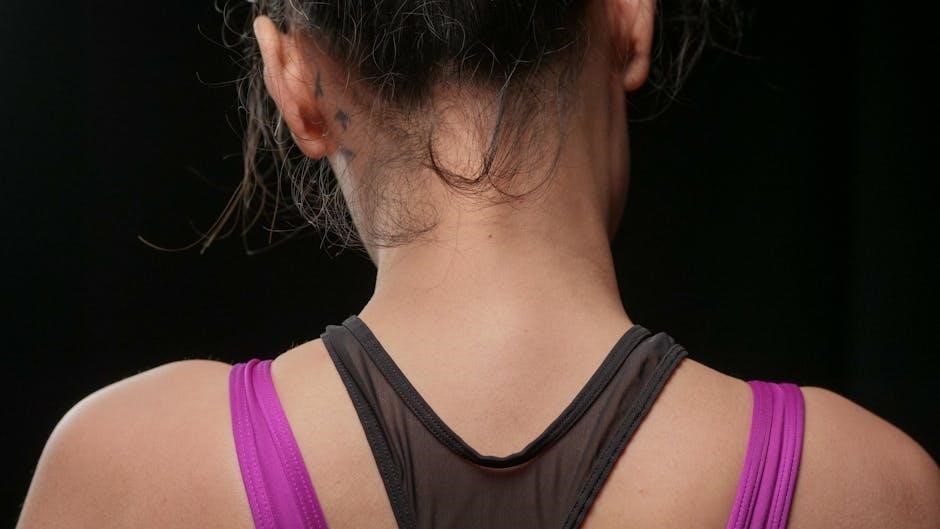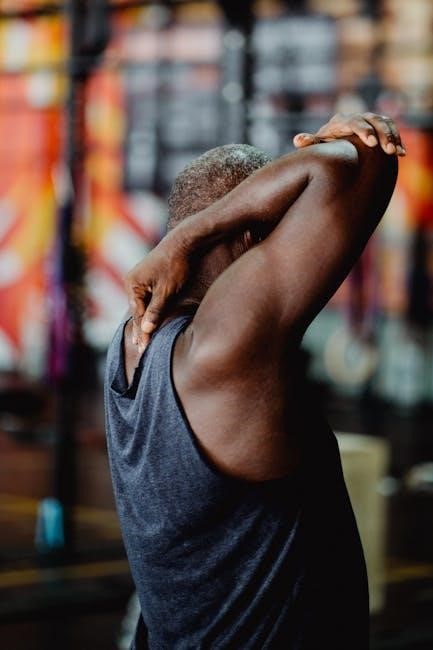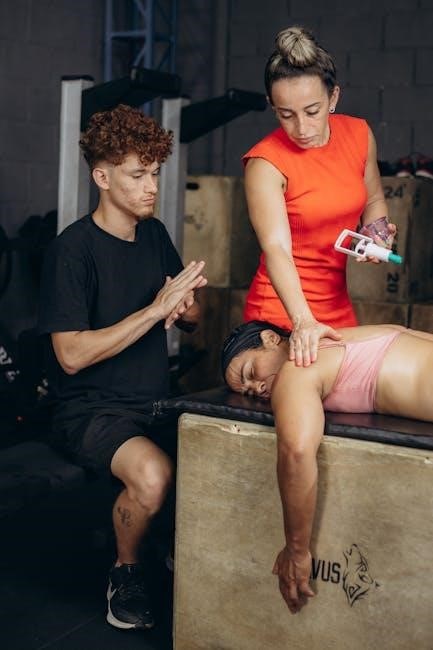Shoulder Pendulum Exercises PDF: A Comprehensive Guide
Welcome to our detailed guide on shoulder pendulum exercises! This resource offers expert-approved workouts to improve mobility, strength, and flexibility. Perfect for rehabilitation and pain relief, these exercises are easy to follow and can be done at home. Download the PDF now and start your journey to a healthier shoulder!
Shoulder pendulum exercises are a fundamental component of shoulder rehabilitation, designed to improve mobility, reduce stiffness, and alleviate pain. These exercises involve gentle, controlled movements of the arm, typically performed while leaning forward and allowing the arm to hang freely. By mimicking the natural motion of a pendulum, they help restore range of motion and strength without putting undue strain on the shoulder joint. Often recommended after injuries, surgeries, or for conditions like frozen shoulder, pendulum exercises are simple yet effective. They can be performed at home with minimal equipment, making them an accessible option for recovery. This guide provides a detailed overview of these exercises, ensuring a safe and progressive approach to shoulder health.

Key Concepts
Shoulder pendulum exercises focus on gentle, controlled movements to improve mobility, reduce pain, and restore function. They are ideal for post-injury or surgery rehabilitation, promoting natural healing and strength.
What Are Pendulum Exercises?
Pendulum exercises are a series of gentle, controlled movements designed to enhance shoulder mobility and flexibility. They involve bending forward and allowing the arm to hang freely, using gravity to guide the arm through circular or swinging motions. These exercises are typically performed without resistance, relying on the natural movement of the body to promote healing and restore range of motion. They are often recommended for individuals recovering from shoulder injuries, surgeries, or conditions like frozen shoulder, as they are low-impact and can be modified to suit different stages of recovery. Regular practice helps reduce stiffness, alleviate pain, and improve overall shoulder function.
Benefits of Pendulum Exercises
Pendulum exercises offer numerous benefits for shoulder health and recovery. They are particularly effective in reducing pain and stiffness, especially after surgery or injury. By promoting gentle, controlled movements, these exercises help improve flexibility and restore range of motion. They are low-impact, making them ideal for early-stage rehabilitation without putting excessive strain on the shoulder. Regular practice can also prevent future injuries by strengthening the surrounding muscles and enhancing joint stability. Additionally, pendulum exercises are simple to perform and require minimal equipment, making them accessible for home use. They are a valuable tool for individuals recovering from conditions like frozen shoulder or rotator cuff injuries, aiding in the gradual restoration of mobility and function.
Common Conditions Treated
Shoulder pendulum exercises are highly effective in addressing a variety of shoulder-related conditions. They are commonly used to treat frozen shoulder, adhesive capsulitis, and rotator cuff injuries. These exercises also aid in post-surgical recovery, helping to restore mobility and strength. Additionally, they are beneficial for individuals experiencing shoulder stiffness, pain, or limited range of motion due to trauma or overuse. By promoting gentle, controlled movements, pendulum exercises can alleviate symptoms and improve function in cases of subscapularis tears and other degenerative shoulder conditions. They are particularly useful during the early stages of rehabilitation, where minimal strain on the joint is crucial. Overall, these exercises provide a safe and effective way to manage and recover from a wide range of shoulder injuries and conditions, making them a cornerstone of many rehabilitation programs.

Preparation and Safety
Ensure proper posture and support. Wear a shoulder sling when not exercising. Use a chair or table for balance. Avoid overexertion and follow a gradual progression of movements.

Importance of Proper Setup
Proper setup is crucial for effective and safe shoulder pendulum exercises. Begin by standing or sitting with good posture, ensuring your unaffected arm is supported on a table or chair. Lean forward slightly, allowing your affected arm to hang freely. This position maximizes the natural swing of the arm, guided by gravity, and reduces strain on the shoulder joint. Proper alignment prevents unnecessary tension and promotes healing. Always maintain a relaxed shoulder and avoid forcing movements beyond a comfortable range. Correct setup ensures the exercise targets the intended muscles and joints, enhancing mobility and strength without risking further injury. Consistency in proper form is key to achieving optimal results and preventing complications during rehabilitation.
Necessary Equipment
To perform shoulder pendulum exercises effectively, minimal equipment is required, making them accessible for home rehabilitation. A sturdy table or chair is essential for support during the exercises, allowing you to lean forward comfortably. Your unaffected arm can rest on this surface to stabilize your body. A shoulder sling or immobilizer may be used initially to protect the surgical repair, though it can be removed during exercise sessions. Light weights, such as small water bottles or resistance bands, can be introduced in later stages to enhance strength. Ensure all equipment is secure and within reach to maintain balance and focus on the movement of the affected arm. Proper equipment setup ensures safety and effectiveness, promoting progress in mobility and recovery.
Safety Tips
When performing shoulder pendulum exercises, prioritize your safety to avoid injury or setbacks. Always listen to your body and stop if you experience sharp pain or discomfort. Avoid overexertion, especially in the early stages of recovery. Ensure you have a stable support surface, such as a table or chair, to maintain balance. Use your non-operative arm for additional support when leaning forward. Keep your movements slow and controlled, focusing on gentle swings rather than forceful motions. Never neglect the use of a sling or immobilizer outside of exercise sessions, especially after surgery, to protect your shoulder. Gradually increase the range of motion as your strength and flexibility improve. If pain persists or worsens, consult your healthcare provider before continuing the exercises.

Shoulder Pendulum Exercises
Shoulder pendulum exercises are a foundational element in rehabilitation, involving gentle arm swings to enhance flexibility and strength. Performed while leaning forward, they promote smooth, controlled movements, aiding recovery.
Basic Pendulum Exercise
The basic pendulum exercise is a simple yet effective movement to improve shoulder mobility. Stand and lean forward slightly, supporting yourself with your unaffected arm on a table or chair. Allow your affected arm to hang straight down, relaxed. Gently swing your arm in small circles, first clockwise and then counterclockwise. Start with small circles (about 6-8 inches in diameter) and gradually increase the size as your comfort allows. Perform 5-10 revolutions in each direction, 2-3 times daily. Avoid forcing the movement; let gravity guide the swing. If comfortable, you can add a light weight (less than 1 pound) to enhance the stretch. This exercise helps reduce stiffness, improve flexibility, and promote healing in the shoulder joint. Always stay within a pain-free range and progress slowly.
Circular Motions
Circular motions are a core component of shoulder pendulum exercises, designed to enhance mobility and reduce stiffness. Stand and lean forward, supporting yourself with your unaffected arm. Let the affected arm hang straight down, then gently swing it in small circles (about 6-8 inches in diameter). Perform 5-10 revolutions clockwise and counterclockwise. Gradually increase the circle size as comfort allows, but avoid forcing the movement. Repeat 2-3 times daily. To progress, you can add a light weight (less than 1 pound) to the affected arm. This exercise promotes smooth joint movement, improves flexibility, and helps restore range of motion. Keep your movements slow and controlled, focusing on relaxation. If pain occurs, stop and consult your healthcare provider. Consistency is key to achieving long-term benefits and preventing future shoulder issues.
Forward and Backward Swings
Forward and backward swings are an essential variation of shoulder pendulum exercises, targeting flexibility and mobility. Stand and lean slightly forward, using your unaffected arm for support. Allow the affected arm to hang straight down. Gently sway your body forward and backward, creating a smooth, controlled motion with your arm. Start with small movements and gradually increase the range as comfort allows. Perform 5-10 repetitions in each direction, repeating for 2-3 sets daily. This exercise helps reduce stiffness and enhances shoulder joint mobility. To progress, you can incorporate a light weight (less than 1 pound) in the affected hand. Focus on maintaining relaxation and avoid forcing the movement. If discomfort arises, stop the exercise and consult your healthcare provider. Consistent practice will help restore range of motion and strengthen the shoulder without strain.
Side-to-Side Swings
Side-to-side swings are a valuable component of shoulder pendulum exercises, designed to enhance flexibility and reduce stiffness. Begin by bending at the waist and supporting yourself with your unaffected arm on a table or chair. Allow the affected arm to hang straight down. Gently shift your body weight from side to side, allowing your arm to swing naturally in a smooth, controlled motion. Perform 5-10 repetitions in each direction, completing 2-3 sets daily. This exercise helps improve shoulder joint mobility and reduces pain. To progress, consider adding a light weight (less than 1 pound) to the affected hand. Focus on maintaining relaxation and avoid forcing the movement. If discomfort arises, stop and consult your healthcare provider. Regular practice will help restore range of motion and strengthen the shoulder without strain.
Weight-Assisted Exercises
Weight-assisted exercises are an advanced form of shoulder pendulum exercises, designed to gradually increase strength and flexibility. To perform this exercise, start by bending at the waist and supporting yourself with your unaffected arm on a table or chair. Hold a light weight (less than 1 pound) in the affected hand, allowing your arm to hang straight down. Gently swing your arm in small circles, starting with 5-10 revolutions in each direction. As you progress, you can increase the size of the circles or add forward-and-backward motions. This exercise helps strengthen the shoulder muscles while maintaining joint mobility. Begin with minimal weight and gradually increase as your strength improves. Always prioritize proper form and avoid any movement that causes pain. Weight-assisted exercises are an excellent way to enhance your pendulum routine and promote long-term shoulder health.

Advanced Techniques
Once you’ve mastered the basic pendulum exercises, you can incorporate advanced techniques to further challenge your shoulder mobility and strength. One method is to add resistance using light weights or resistance bands while performing the swings. This helps build muscle endurance and enhances flexibility. Another advanced technique involves combining pendulum movements with controlled arm rotations, such as figure-eight patterns or diagonal swings. These variations target multiple planes of motion, improving coordination and range of motion. Additionally, you can progress to 3D circular movements, alternating between small and large circles to engage the shoulder joint fully. Always start slowly and increase difficulty only when comfortable. These advanced techniques are ideal for individuals looking to progress beyond the foundational exercises and achieve a higher level of shoulder rehabilitation and strength.

Rehabilitation and Recovery
Shoulder pendulum exercises are essential for rehabilitation, promoting gentle mobility and reducing stiffness. They aid in post-surgery recovery, improving range of motion and managing pain effectively without strain.
Role in Recovery
Shoulder pendulum exercises play a crucial role in recovery by gently restoring mobility and reducing stiffness. They are particularly effective in the early stages of rehabilitation, allowing the shoulder to heal without strain. By promoting blood flow and gradual movement, these exercises help prevent adhesions and scar tissue formation. Pendulum exercises are often recommended after shoulder surgery or injuries, as they provide a controlled way to improve range of motion. They are low-impact and can be adjusted to suit individual progress, making them ideal for patients recovering from conditions like frozen shoulder or rotator cuff injuries. Consistency in performing these exercises ensures a smoother transition to more active rehabilitation phases, ultimately supporting the return of strength and functionality to the shoulder joint.
Post-Surgery Rehabilitation
Post-surgery rehabilitation often begins with shoulder pendulum exercises to promote healing and restore function. These exercises are gentle and non-stressful, making them ideal for the initial recovery phase. After shoulder surgery, patients are typically advised to wear a sling to protect the repair. However, pendulum exercises can be performed while wearing the sling or immediately after removing it. By leaning forward and allowing the arm to hang freely, patients can perform small, controlled movements that reduce stiffness and improve mobility. These exercises are particularly beneficial for preventing adhesions and promoting blood flow to the healing tissues. Consistency is key, as regular practice helps gradually restore range of motion and strength. Always follow the guidance of your healthcare provider and avoid any movements that cause significant pain or discomfort during the post-surgery period.
Preventing Future Injuries
Shoulder pendulum exercises are not only beneficial for recovery but also play a crucial role in preventing future injuries. By improving flexibility, strengthening the muscles around the shoulder joint, and enhancing overall mobility, these exercises help reduce the risk of re-injury. Regular practice promotes joint stability and proper movement patterns, which are essential for long-term shoulder health. Consistency is key, as maintaining strong and flexible shoulders can prevent strains and improve durability during daily activities or sports. Start with small, controlled movements and gradually increase intensity to ensure proper form and avoid overexertion. Incorporating pendulum exercises into your routine can significantly lower the likelihood of future shoulder-related issues, keeping you active and pain-free for years to come. Always consult a healthcare provider to tailor your routine to your specific needs and goals.

Exercise Guidelines
Perform pendulum exercises 5 times daily in 5-10 minute sessions. Start with small circles and gradually increase size as symptoms improve. Use pain as your guide to avoid overexertion. Always maintain proper form and progress slowly for optimal results. Consult a healthcare provider to tailor your routine to specific needs and goals.

Frequency and Duration
For optimal results, perform shoulder pendulum exercises 5 times daily in 5-10 minute sessions. Start with 3 sets of 10 repetitions per direction, gradually increasing as comfort allows. Gentle, consistent practice promotes healing without overexertion. Duration can extend as mobility improves, but always prioritize pain-free movement. Avoid aggressive progression to prevent setbacks. Regularity is key to enhancing flexibility and strength. Adjust frequency and duration based on individual recovery pace and medical guidance. Consistency, paired with proper technique, ensures effective rehabilitation and long-term shoulder health. Listen to your body and modify sessions as needed to maintain comfort and progress safely.
Progressing Your Routine
As your shoulder improves, gradually increase the intensity of your pendulum exercises. Start with small circles and slowly enlarge the diameter as mobility allows. Introduce variations like forward-backward or side-to-side swings to target different muscle groups. Once comfortable, add light weights to enhance strength. Avoid forcing movements that cause sharp pain. Progression should be gradual, ensuring each step feels manageable. If pain increases, revert to earlier stages and consult your therapist. Incorporating advanced techniques, such as controlled arm movements, can further improve range and strength. Always prioritize smooth, controlled motions over speed or force. Use pain as your guide to avoid overexertion. A balanced progression ensures steady improvement without risking setbacks. Tailor your routine to your recovery pace for the best outcomes.
Pain Management
When performing shoulder pendulum exercises, it’s crucial to listen to your body and manage pain effectively. Mild discomfort is normal, but sharp pain or swelling should prompt you to stop. Always use pain as your guide; if an exercise exacerbates your symptoms, modify or avoid it. Apply ice to the affected area after exercises to reduce inflammation. Overexertion can delay healing, so avoid pushing through significant pain. Instead, gradually increase your range of motion as comfort allows. If pain persists or worsens, consult your healthcare provider or physical therapist for further guidance. Balancing activity with rest ensures a safe and effective recovery. Remember, consistent, gentle progress is key to managing pain and achieving long-term shoulder health.

Sample Exercise Routine
Start with 5-10 minute sessions, performing 3 sets of 10 repetitions for each exercise. Gradually increase your range as comfort allows. Ideal for morning and evening routines.
Morning Routine
Begin your day with gentle shoulder pendulum exercises to improve mobility and reduce stiffness. Stand and lean forward slightly, allowing your affected arm to hang down. Perform small circular motions for 5-10 minutes, gradually increasing the diameter as comfort allows. Repeat this exercise 3-5 times, ensuring smooth, controlled movements. Follow with forward and backward swings, then side-to-side motions to enhance flexibility. Conclude with gentle stretching to relieve tension. This routine helps restore range of motion and prepares your shoulder for daily activities. Always prioritize pain-free movements and adjust as needed. For detailed steps and progression, refer to the downloadable Shoulder Pendulum Exercises PDF guide.
Evening Routine
Wind down with a soothing evening routine to relax your shoulders and promote recovery. Begin by standing and leaning forward slightly, allowing your affected arm to hang loosely. Perform gentle circular motions for 5-10 minutes, starting with small circles and gradually increasing the size as comfort allows. Follow with forward and backward swings, then side-to-side motions to release tension. Repeat each exercise 5-10 times, focusing on smooth, controlled movements. Avoid forcing your shoulder beyond a pain-free range. Conclude with gentle stretching to enhance flexibility and reduce stiffness. This routine helps unwind your muscles and prepares your shoulder for rest. For a detailed guide, download the Shoulder Pendulum Exercises PDF and follow the illustrated steps for optimal results.
Shoulder pendulum exercises are a powerful tool for improving mobility, reducing pain, and promoting recovery. Consistency is key—perform these exercises regularly to achieve lasting benefits. Always listen to your body and avoid pushing past discomfort. The Shoulder Pendulum Exercises PDF provides a comprehensive guide to help you navigate your rehabilitation journey. Whether you’re recovering from surgery, managing chronic pain, or improving flexibility, these exercises offer a gentle yet effective approach. Remember to consult with a healthcare professional to tailor the routine to your specific needs. With patience and dedication, you can restore strength and function to your shoulder. Empower your recovery process with this easy-to-follow guide and take the first step toward a pain-free, active lifestyle.
